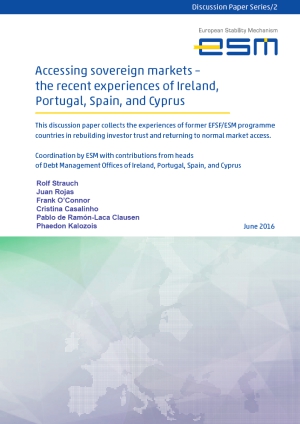Download PDF: Discussion Paper 2
This discussion paper collects the experiences of former EFSF/ESM programme countries in rebuilding investor trust and returning to normal market access.
Coordination by ESM with contributions from heads of Debt Management Offices of Ireland, Portugal, Spain, and Cyprus
Authors:
Rolf Strauch - European Stability Mechanism
Juan Rojas - European Stability Mechanism
Frank O'Connor - NTMA - Ireland
Cristina Casalinho - IGCP - Portugal
Pablo de Ramón-Laca Clausen - Tesoro - Spain
Phaedon Kalozois - PDMO - Cyprus
Executive summary:
A defining feature of the euro crisis, which we experienced over the past few years, is that market access broke down for some countries or was impaired. Some countries could not find sufficient investors to cover their needs or could not do so entirely at a sustainable cost. In the past crisis, this happened to Greece, Ireland, Portugal, Spain, and Cyprus. This discussion paper collects the experiences of several of these euro area countries as they developed strategies to regain access to affordable financial market financing.
Euro area governments created a crisis resolution framework that included the European Financial Stability Facility (EFSF), and European Stability Mechanism (ESM), to help countries regain market access. Governments undergo adjustment programmes or undertake measures to repair the banking sector – that is, to “bring their house in order” and regain investors’ trust. For the programme period, a country’s financing gap is covered by the EFSF/ESM. During this period, DMOs managed to keep to different degrees some limited market financing and importantly had to launch a strategy to regain full market access.
By now, four of the five countries that underwent an EFSF or ESM programme have successfully exited. The objective of this discussion paper is to document the steps which DMOs in Ireland, Portugal, Spain, and Cyprus took to structure their financing during the programme period, where possible, and the strategy they launched in approaching domestic and international bond markets.
Approaches to regaining market access in Ireland, Portugal, and Cyprus show similar phases. It starts with a renewed ramping up of communication and investor contacts, opportunistic issuances and then more broad-based bill and bond issuance. Spain maintained broader market access over the programme period and therefore deviates in this respect. However, interestingly, all countries embarked on some innovation in their investor relations, products or issuance technologies, when comparing the pre- and post-programme period. The differences reflect both each country’s specific market conditions and common factors. An important commonality seems to be the reliance on a sizeable cash buffer as an assurance for investors if a country re-enters markets at a sub-investment grade rating.
Market access strategies are not deployed in isolation, but their success hinges on domestic and European policies. First, firm and credible programme implementation is a key condition for gaining investors’ trust and successfully accessing markets. Second, the EFSF and ESM terms of lending at concessional rates and very long maturities facilitate private sector engage-ment in the programme and post-programme period. Third, monetary policy crucially determines market conditions. The impact of low interest rates and the European Central Bank’s quantitative easing programme can hardly be over-emphasised in explaining investor demand and yields for former pro-gramme countries.
The DMOs from Ireland, Portugal, Spain, and Cyprus for contribute their experiences to this paper. They explain and put in context their strategies to regaining full market access. Presenting the DMOs’ account on market access of former programme countries fills a gap in the narrative of the country experiences through the crisis. It also offers lessons to better understand market reactions and DMOs’ capabilities which may be helpful in the future.
Disclaimer: The views expressed in this discussion paper are those of the authors and do not necessarily represent those of the ESM or ESM policy. No responsibility or liability is accepted by the ESM in relation to the accuracy or completeness of the information, including any data sets, presented in this paper.
